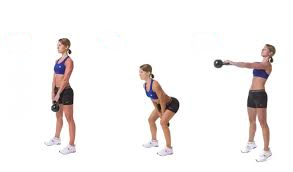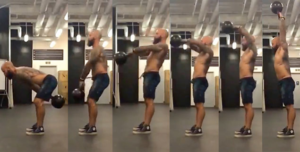
This is another article targeting observed technical errors and incorrect training volumes in my gym.
Today’s article is on the use of Kettlebells and in particular the standard Kettlebell swing. I will refer to Kettlebells as ‘KB’ from here onwards.
There are two main types of KB swings, the original “Russian” KB swing and the modified “American” KB swing.
There are several differences between these two techniques:
The Russian KB swing is typified by: 
- More upright posture at the start position
- Smaller KB range of motion
- Less hip extension at the finish position
- Typically heavier KB.
——————————————–
The American KB swing is typified by: 
- Excessive hip flexion at the start
- Excessive hip Extension at the finish
- Using lighter KB’s.
.
Interestingly this training methodology is another of those “Eastern European” vintage exercises (when cushy gyms weren’t the rave!!!). Unfortunately like many of the exercise transitions from Eastern European to North American, the basic fundamentals of the exercise has been changed and this has led to the creation of a more dangerous exercise that for the uninitiated can quickly result in excessive strain and injury.
My two main concerns with this exercise are:
1. The American technique requires a very large range of motion which places the lumbar spine/pelvic positioning in “awkward” positions both at the start and end of the motion.
2. From an observer’s viewpoint – KB swings appear to be a simple exercise to complete – resulting in clients often completing 100+ repetitions in a single session!!
RANGE OF MOTION:
The excessive Range of motion in the American KB swing is problematic at both ends of the movement.
EXTENSION: 
Research [1] indicates that the emphasis on rapid/excessive hip extension at the top of the movement results in a lumbar hyper-extension of around 25% which is at the upper limit of functional lumbar extension range. This extreme range is often required to lift the KB to the above head position resulting in poor posture and the subsequent loading on the lumbar region.
.
FLEXION: 
This aspect of the KB swing is often ignored but this is where I see the biggest risk to the client when performing this exercise.
If the client had good technique, appropriate flexibility and the correct core strength then I would not have an issue with the rapid eccentric loading that is placed upon the posterior chain when dropping down into the hip hinge position of the KB swing start position.
But unfortunately rarely do any of the gym clients who perform this exercise have the above physical requirements.
.
Lack of posterior chain flexibility (Particularly hamstring length).
If the client has poor hamstring flexibility, it will likely be difficult for them to maintain a neutral pelvic tilt when they move into this hip hinge (hip flexion) position. The only way to move into the range that is expected during this exercise if your hamstrings are tight is to allow your pelvis/lumbar spine move into a posterior pelvic tilt/Lumbar flexion position.
Research has shown that once your erector spinae are unable to maintain a neutral lumbar position, then much of the load that is being undertaken is placed upon the lumbar skeletal system (ligaments, capsules, menisci). This is bad enough with just the weight of your upper body, but add to this load a rapidly accelerating KB (16kg+) and the forces being placed upon the lower back are extreme.
Secondly, as I have indicated in many of my previous articles on core strength, if you don’t have the core strength to maintain an appropriate pelvic tilt or creation of intra abdominal pressure, then this lack of strength will only add to the loading placed upon the lumbar spine.
REPETITIONS:
The other factor in KB swings that makes this exercise potentially dangerous is the prescription of very large volumes of swings per session.
It is not uncommon for crossfit clients to perform several 100 KB swings in a single session. Aside from the flexibility & core issues, if you add to the mix generalised fatigue through the core with this amount of work, then even well conditioned clients will still likely place themselves in danger as the workout progresses with fatigue and loss of muscle control taking over.
Often what we see at this point is the client begins to use the momentum of their body to lift the KB to the desired height, resulting in further degradation of technique and an increase in rapid uncontrolled hip extension/hyper-extension.
I often tell my clients, velocity (speed) is not your friend in the gym. There are many better places to adequately apply your new found strength to the development of movement specific power (eg functional fitness training centres & ovals, using medicine balls, bounding, etc) – Aside from Olympic lifters, I for one am a believer that power/velocity training shouldn’t take place by throwing around large pieces of iron in a confined space!!!
SUMMARY:
1. The Russian KB swing has been bastardized into a more dangerous extreme range of motion movement known as the American KB swing.
2. Excessive range of motion and poor flexibility can result in an increased likelihood of soft tissue and/or skeletal injury.
3. High volume workouts increase the risk of injury, particularly when there is weighted high velocity movements involved.


